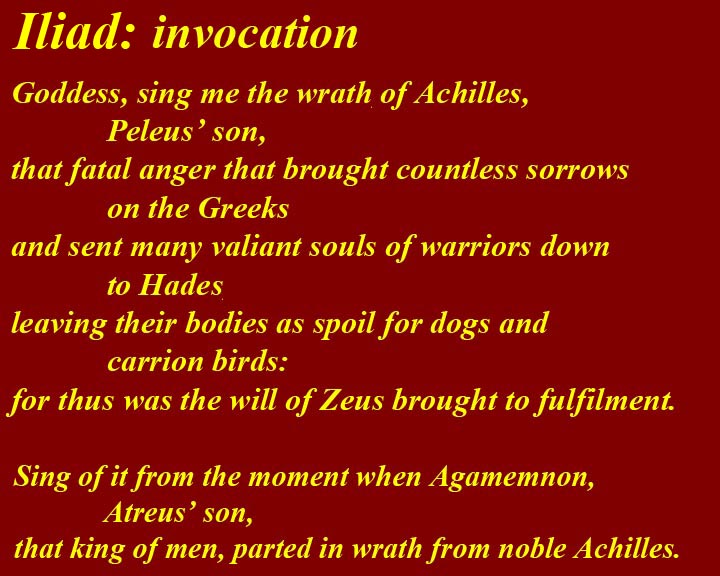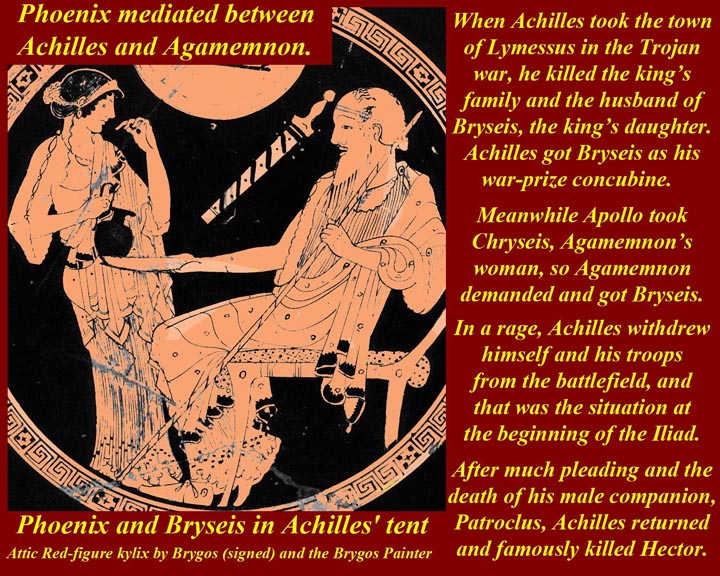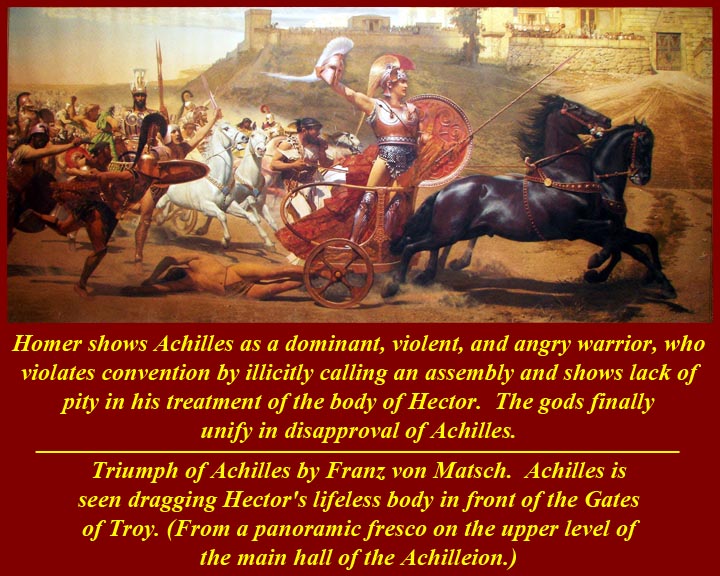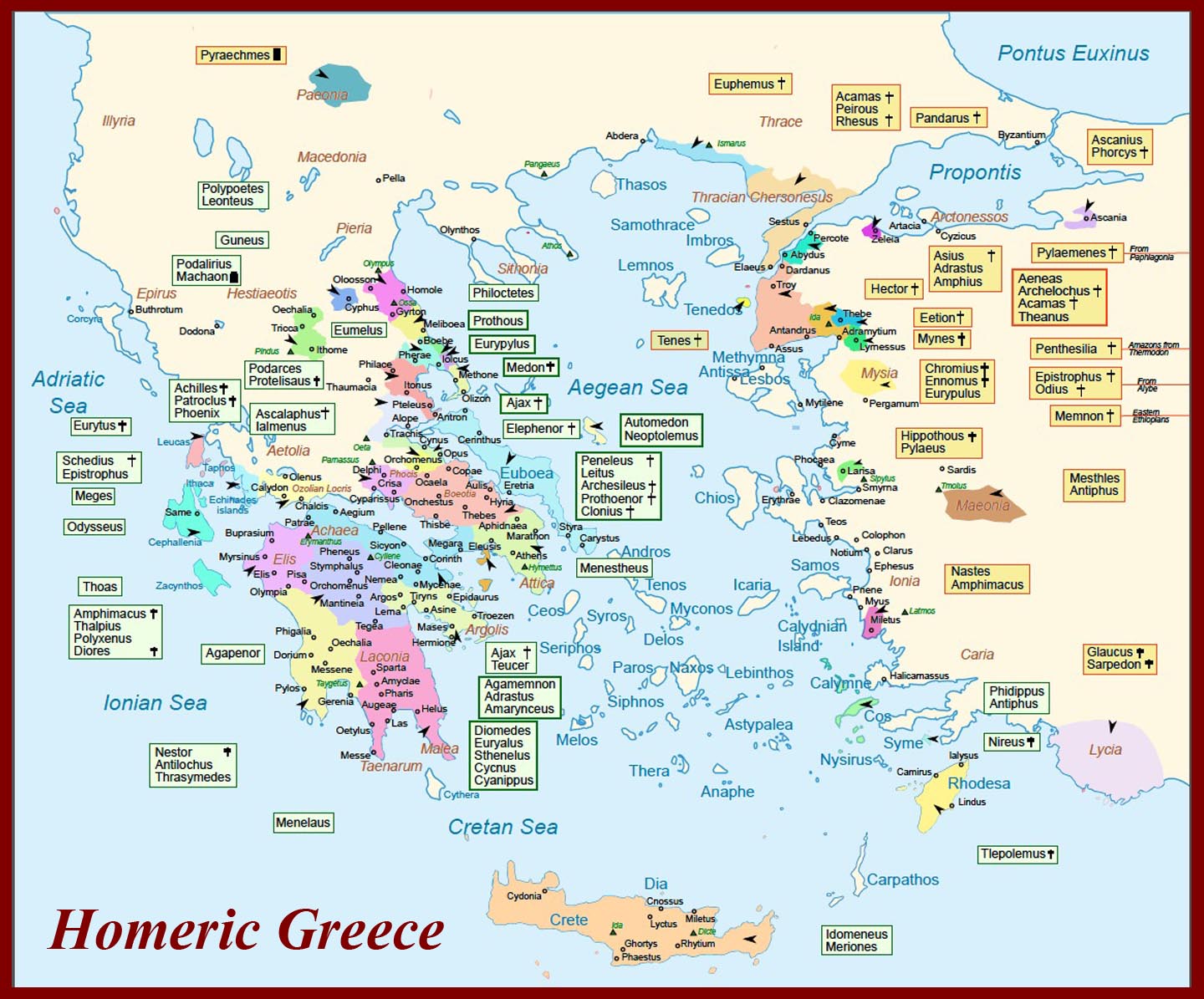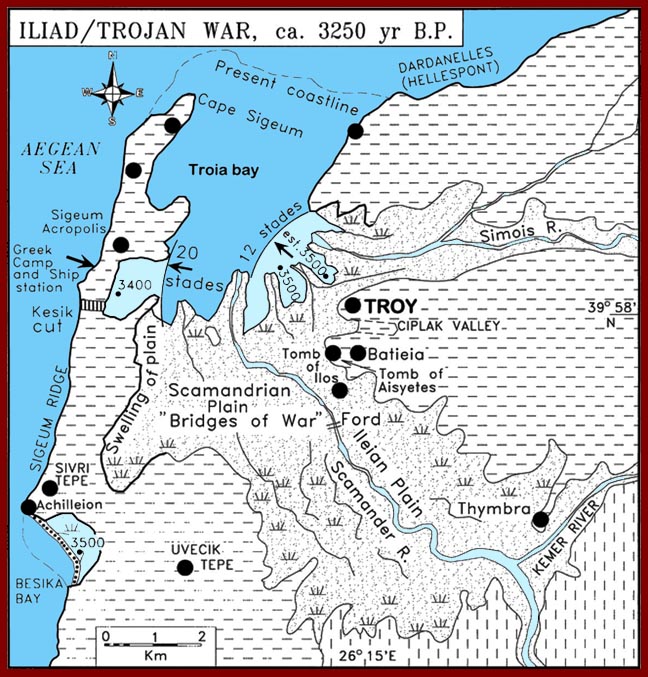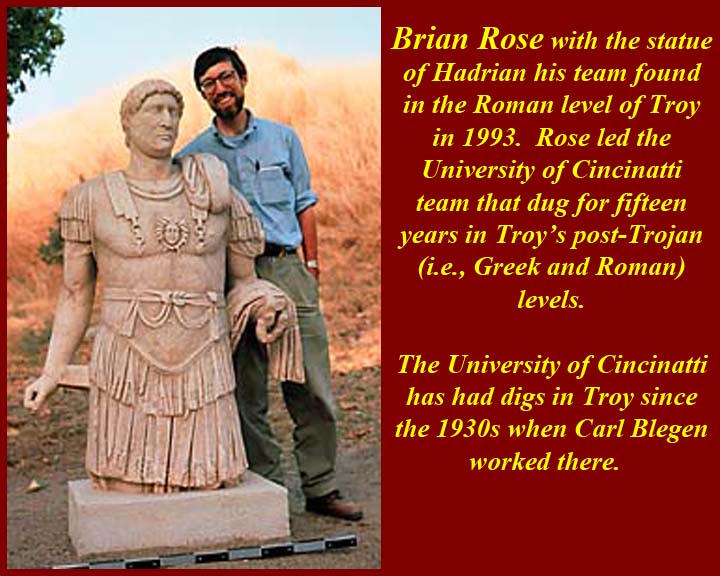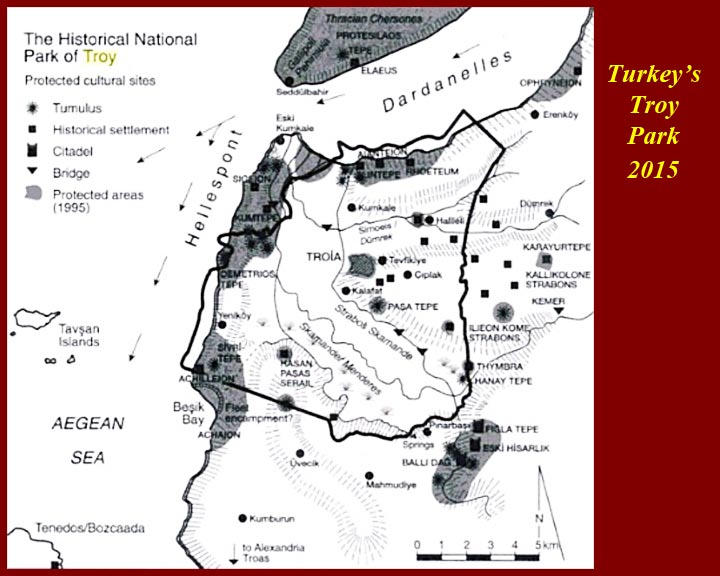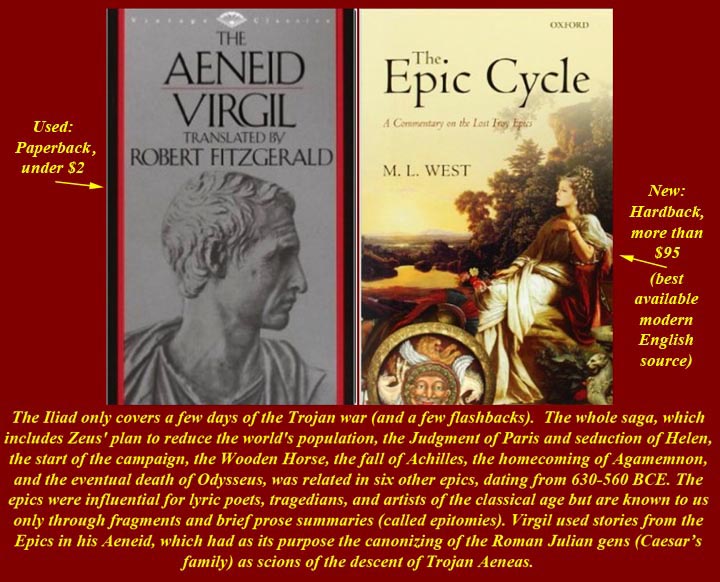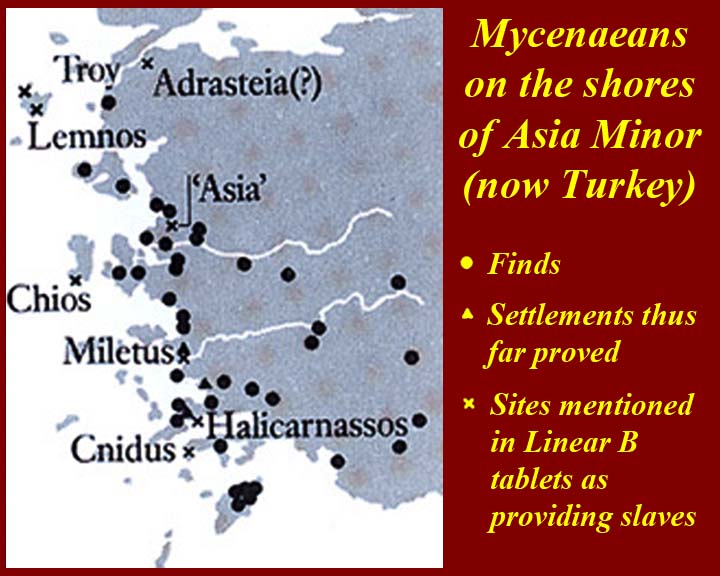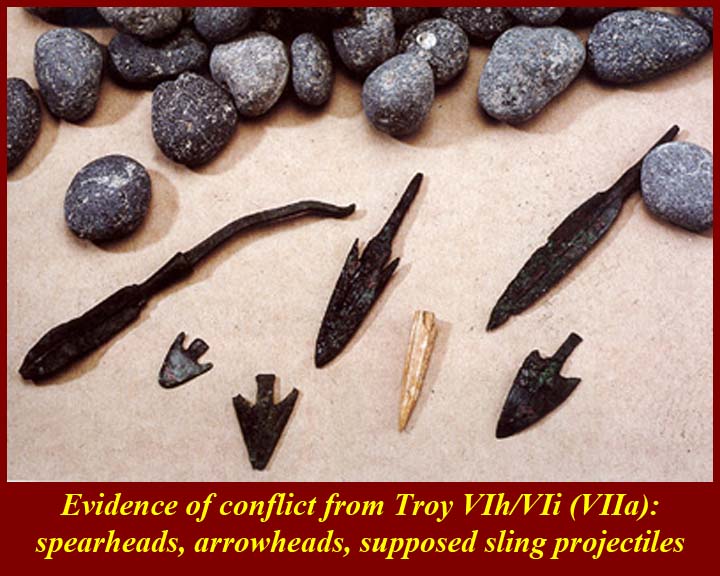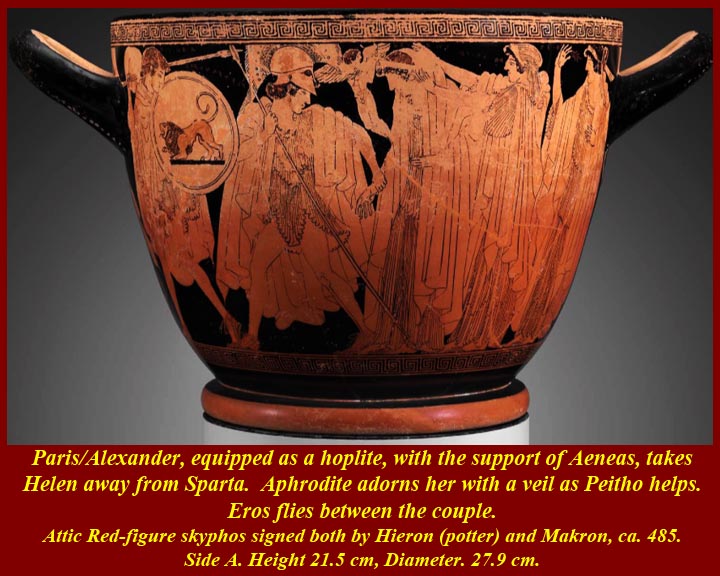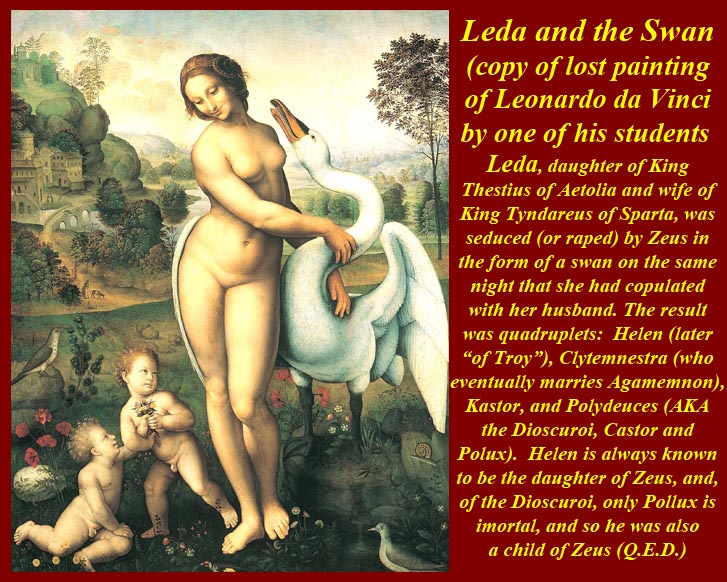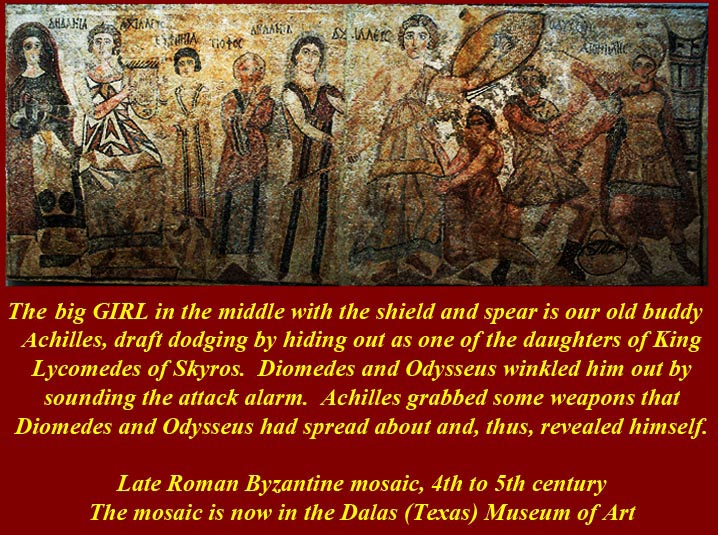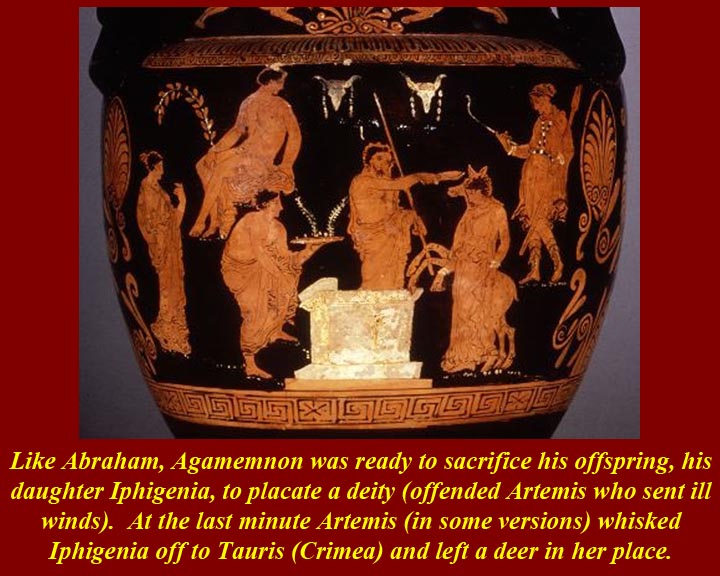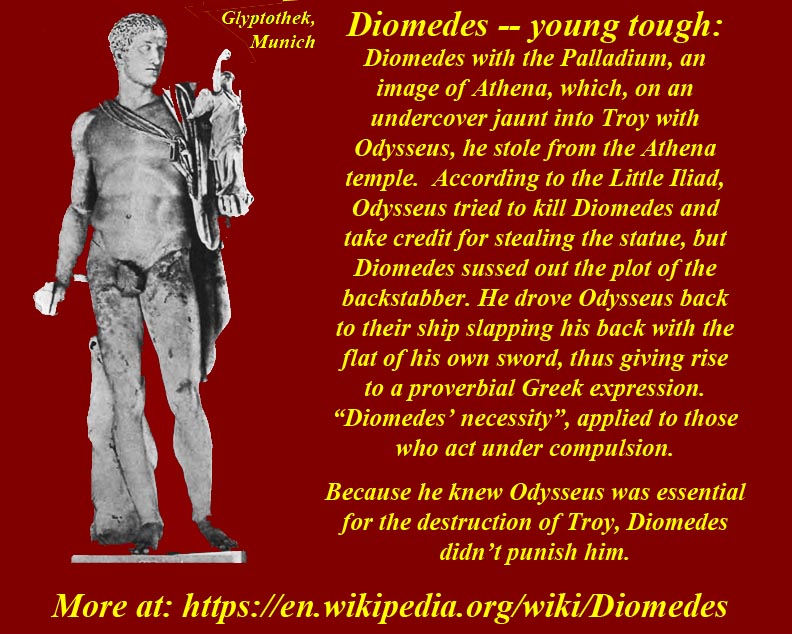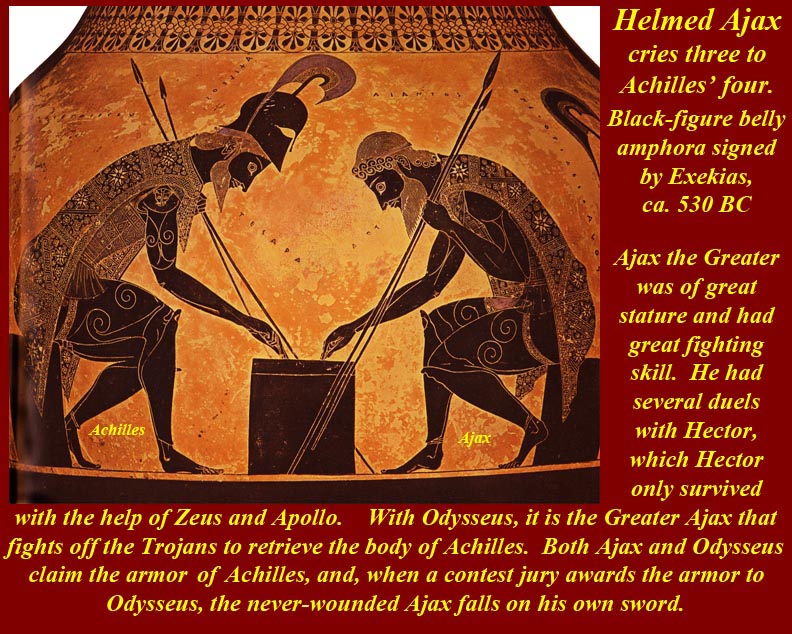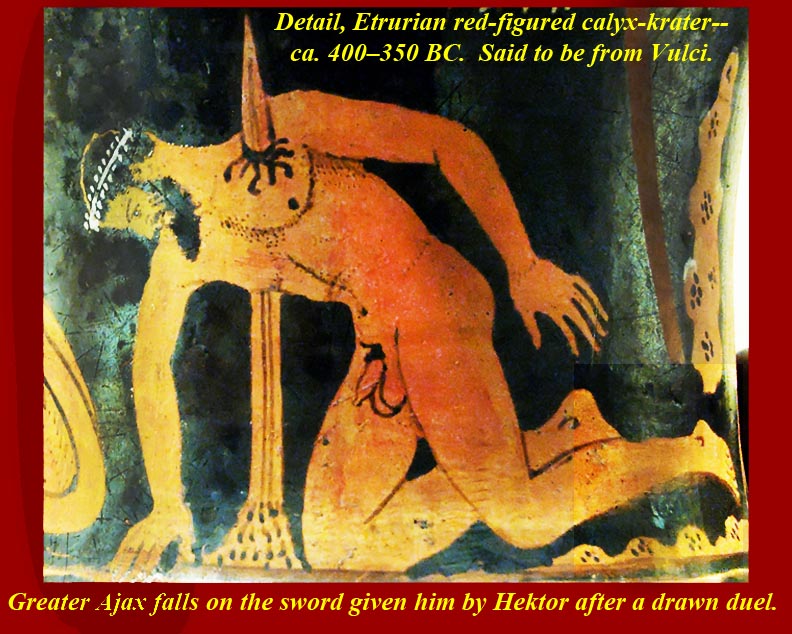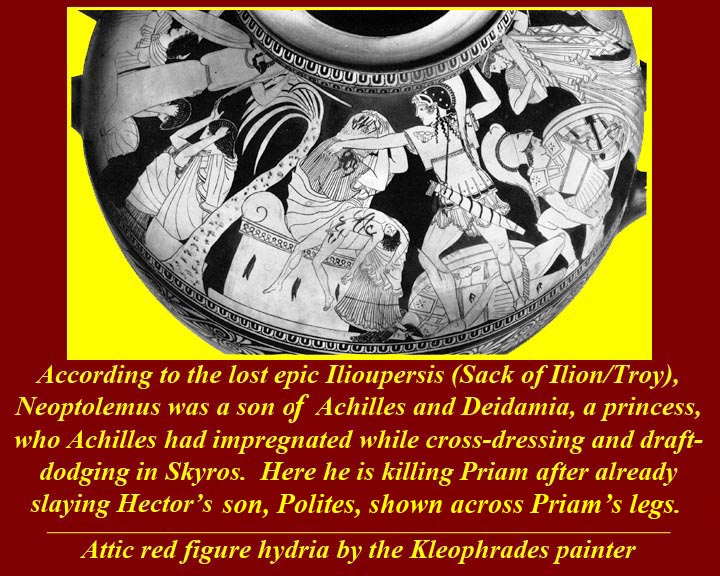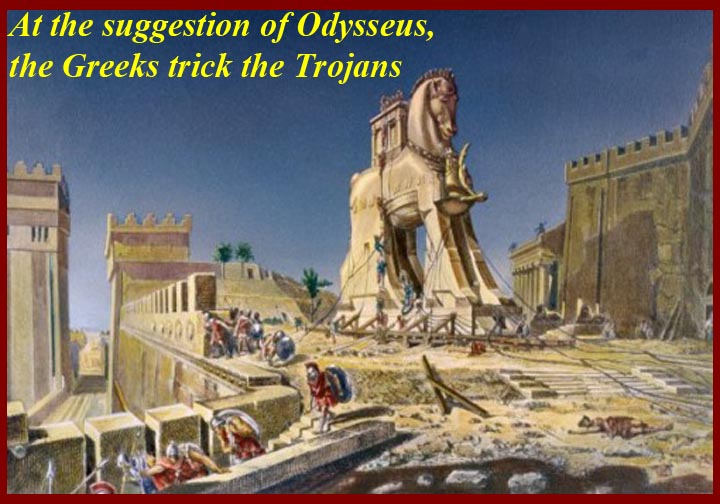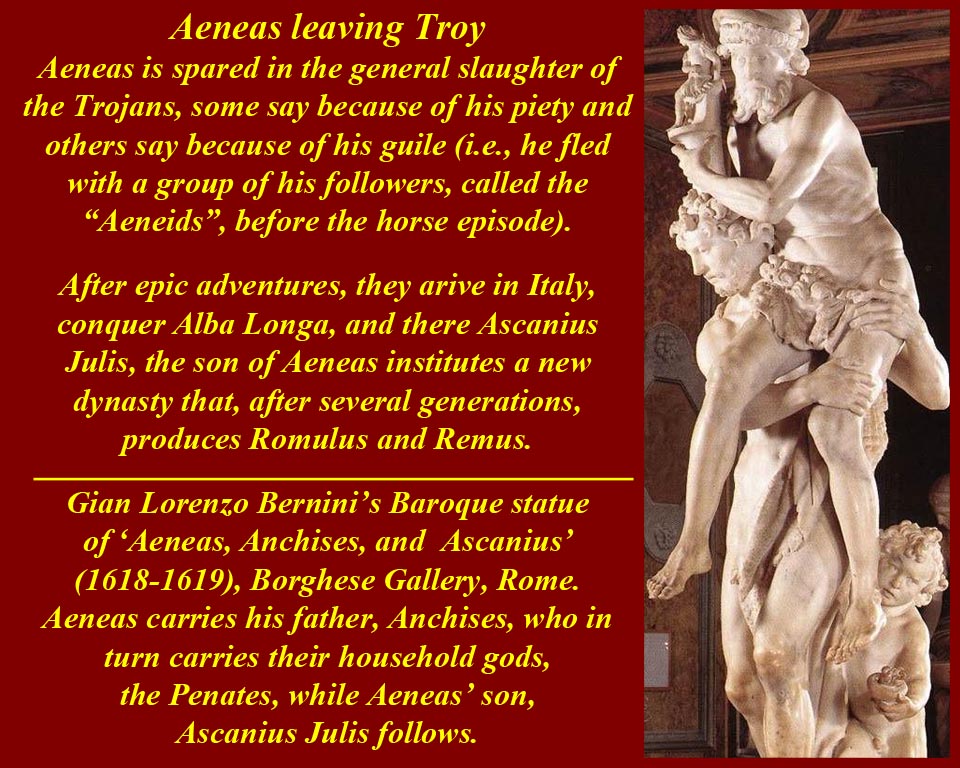Ancient Greece 1
Unit 4 -- Homeric Greece and the Trojan War
From https://en.wikipedia.org/wiki/Homer
Homer (Ancient Greek: Ὅμηρος [hómɛːros], Hómēros) is best known as the author of the Iliad and the Odyssey. He was believed by the ancient Greeks to have been the first and greatest of the epic poets. Author of the first known literature of Europe, he is central to the Western canon.
Whether and when he lived is unknown.
From https://en.wikipedia.org/wiki/Iliad
The Iliad (/ˈɪliəd/;[1] Ancient Greek: Ἰλιάς Ilias, pronounced [iː.li.ás] in Classical Attic; sometimes referred to as the Song of Ilion or Song of Ilium) is an ancient Greek epic poem in dactylic hexameter, traditionally attributed to Homer. Set during the Trojan War, the ten-year siege of the city of Troy (Ilium) by a coalition of Greek states, it tells of the battles and events during the weeks of a quarrel between King Agamemnon and the warrior Achilles.
From https://en.wikipedia.org/wiki/Epic_Cycle
The Epic Cycle (Greek: Ἐπικός Κύκλος, Epikos Kyklos) was a collection of Ancient Greek epic poems that related the story of the Trojan War, which includes the Cypria, the Aethiopis, the so-called Little Iliad, the Iliupersis, the Nostoi, and the Telegony. Scholars sometimes include the two Homeric epics, the Iliad and the Odyssey, among the poems of the Epic Cycle, but the term is more often used to specify the non-Homeric poems as distinct from the Homeric ones.
Aside from the Odyssey and the Iliad, the cyclic epics only survive in fragments, the most important of which is a detailed summary written by someone named Proclus (not the same person as the philosopher Proclus Diadochus).
------------------------------------------------
Click on small images to see larger versions
Homer's Iliad is only a small part of the corpus of information about the Trojan war -- it covers about four months of the tenth and last year of the war.
The first few lines of the Iliad, called its invocation, makes clear the idea that the Iliad is not about the war but about the dispute between two of the Achaeans, Achilles and Agamemnon, and what effect that dispute had on the last year of the War.
The great prize the two "heroes" fell out over was a captive woman, Briseis, who Achilles was awarded after he killed her family. Agamemnon had captured another girl Chryseis (later Cressida), but Apollo fancied her and took her From Agamemnon. Agamemnon, of course, pulled rank and took Briseis, and that caused Achilles to withdraw in a rage to his tent. Neither he nor his myrmidones would fight, and that is what "sent many valiant souls of warriors down to Hades."
It has also been suggested that Achilles was still trying to avoid the early death that was prophesied for him.
The image shows Bryseis with Phoenix who tried to mediate the dispute.
Phoenix was a kindly old warrior, who helped raise Achilles while he himself was still a young man. Achilles deeply loves and trusts Phoenix, and Phoenix mediates between him and Agamemnon during their quarrel.
Homer portrays Achilles as angry, petulant, undisciplined, vengeful, etc. But Homer, of course, also disregards the fact that he and all the other Greek "heroes" are rapists of their female "prizes" and that they ruthlessly slaughter the innocents along with the combatants. (Yes, we are allowed to judge the savages who lived in different times and had different moral standards, just as we judge similar folks of today.)
Achilles does return to the front lines to fight (and to dishonor the dead), but only after his male "companion", Patroclos does so and is slain by Hector. The characterization of the relationship of Achilles and Patroclos, even in ancient times, has ranged from pederasty, through homosexualism of equals, to "band of brothers" chaste military admiration and attachment. See https://en.wikipedia.org/wiki/Achilles_and_Patroclus
The Map shows the places of origin of personages and groups that appear in Homer's Iliad.
The field of action in the Trojan War. Note the position of the shoreline now and in the 1200s BC.
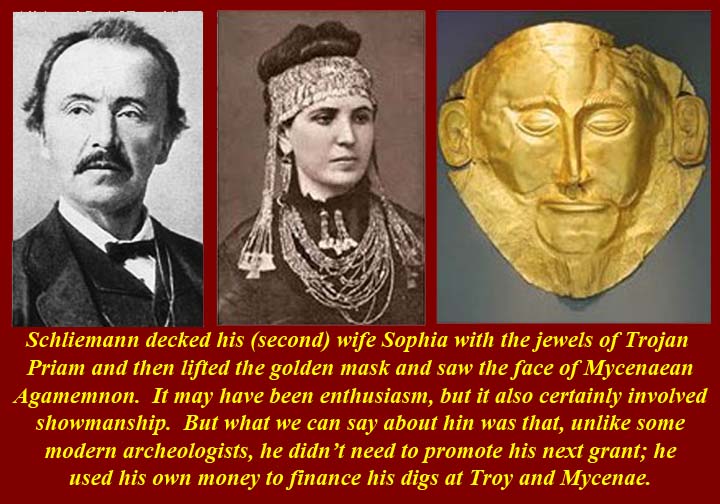

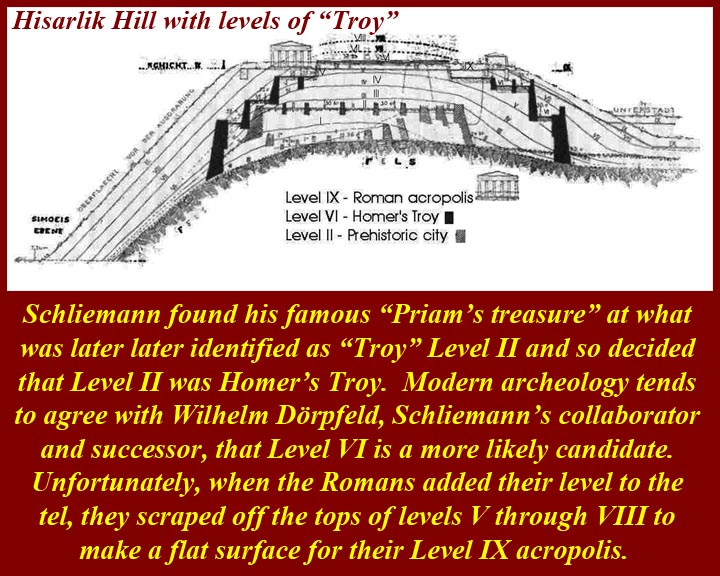
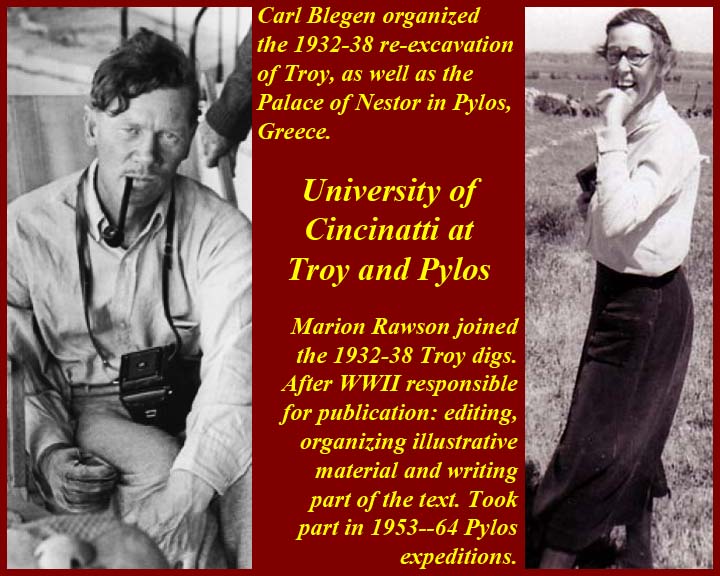
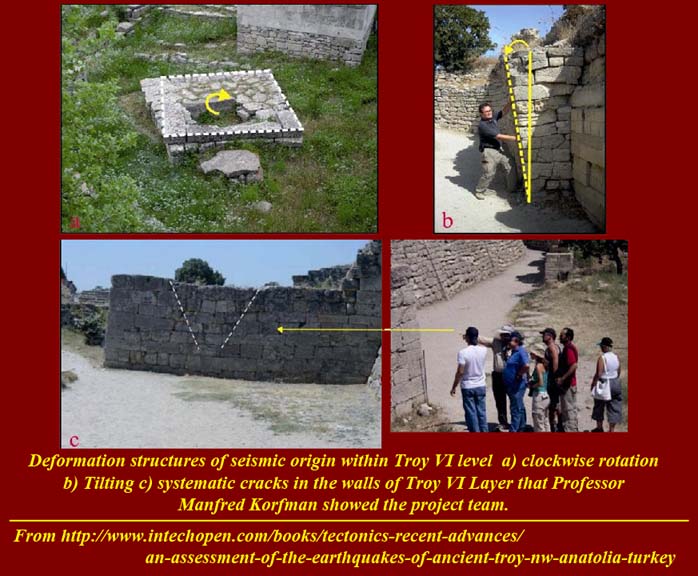
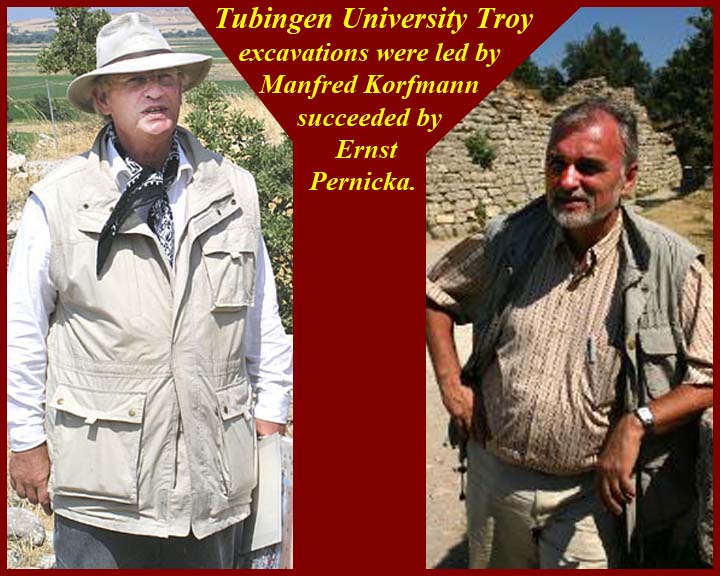
The excavators
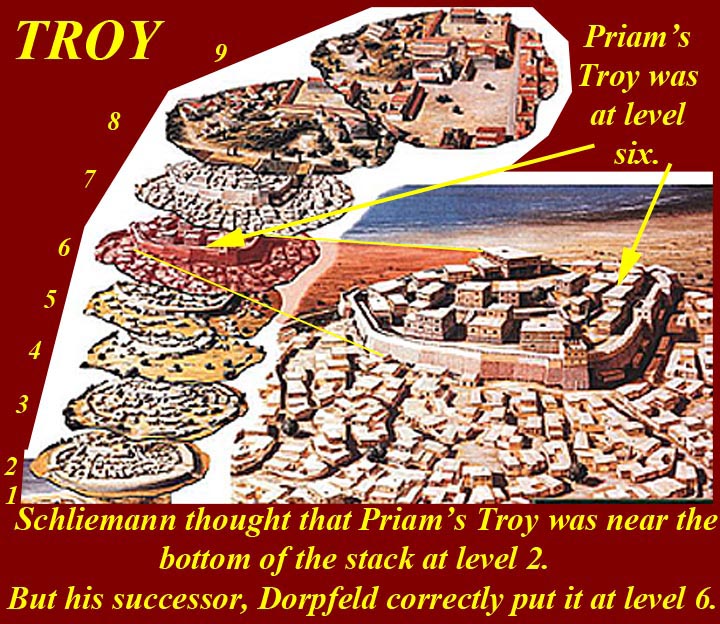
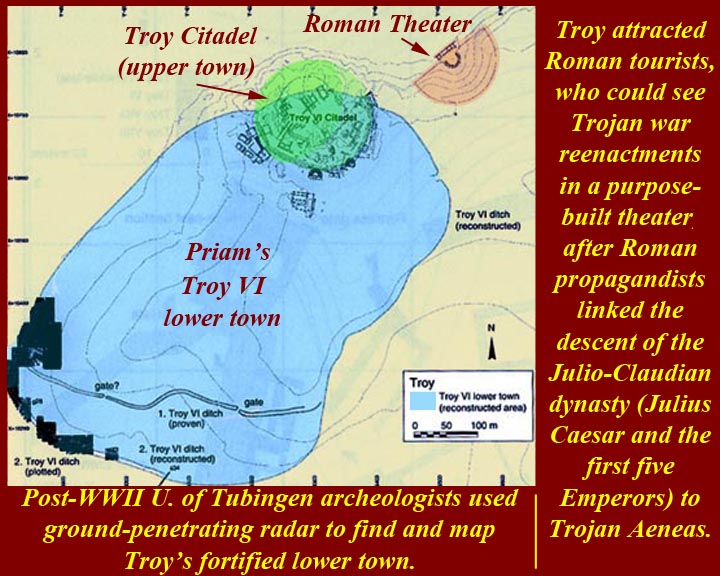
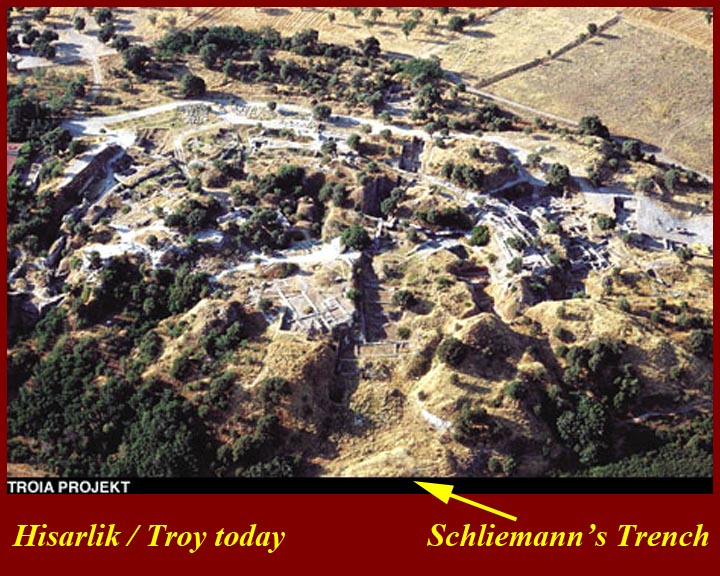
Dorpfeld correctly put Priam's troy at Level VI and said that there was evidence of earthquake damage. Blegen and Dawson agreed that VI was damaged by quakes and that VIIa was destroyed by war. Later excavators have placed what previously was counted as VIIa as VIi, a second phase of destruction caused by war. Kraft, a paleogeologist determined more clearly the ancient shorelines.
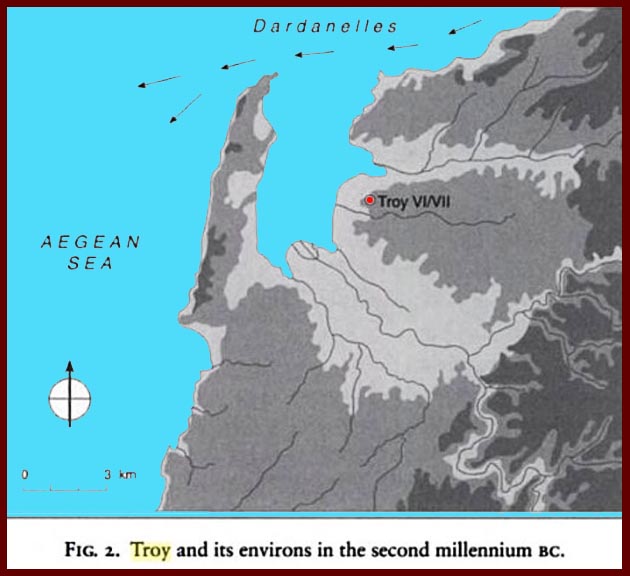
The environs of Troy in the 11th Century BC and the Troy Archeological park and environs today.
Homer's poems and the other epics:


Homer might never have existed, but if he didn't, his two great epics reflect the poetry of someone else known as Homer. (That's an old joke attributed to many different pundits.) See https://en.wikipedia.org/wiki/Homer for more info on the supposed poet/singer/epicographer supposedly known as Homer.
Probably the most canonical translation of the Iliad is the Loeb (A.T. Murray), which has facing pages in the Greek and in English. The Loeb is used in classics, language, and archeology course at universities. The English might feel a bit stilted to casual readers, because, to some extent, it follows the Greek grammar, which casual readers are not expected to know. The Murray translation is also available on the Internet at https://en.wikisource.org/wiki/The_Iliad_(Murray). If you want hardback Loeb volumes of any of the classics, you can usually get them on the internet at on line book sources. The most popular and affordable translation of Homer's Iliad is still the Penguin Paperback (Robt. Fagles).
The Iliad, as mentioned above, is not really about the Trojan war, and, in fact, it only covers a four month period in the tenth year of the war. It does have some explanatory flashbacks. In the Iliad, we get the adventures and misadventures of seven "heroic" characters. The story of the Trojan Horse does not appear in the Iliad -- it is in Book VIII of the other great Homeric epic, the Odyssey. (Similarly the story of Achilles supposed invulnerability, except for his heel, doesn't show up until Roman times when Statius (45-96 AD) wrote about it. See http://wordinfo.info/unit/3648/ip:2.)
The rest of the Trojan War story comes from the "Epic Cycle", six now lost Greek epics that apparently were put down in writing in the seventh century, although, like Homers poems, the may have been sung for many years -- maybe even centuries -- before. Although the epics of the cycle are long gone quotes and epitomes of the epics tell us what they said.
For information on the Epic Cycle, see:
https://en.wikipedia.org/wiki/Epic_Cycle and
http://www.theoi.com/Text/EpicCycle.html
Virgil's epic, the Aeneid, puts a Roman and pro-Julian spin in the story by telling the tale of the escape of Aeneas and his followers from Troy. Signifficantly, it adds th the name of Ascanius (son of Aeneas) the descriptive name Julis (meaning "from Ilion" = the Trojan and posits Julis as the founder of the Roman Julian (Later Julio-Claudian) gens, thereby entering Venus (Aphrodite) into the ancestry of the Julians. The Gens Julia also claimed descent from Mars, who, according to myths, impregnated Rhea Silvia (AKA Julia), the result of which was the birth of Romulus and Remus.
For the AeneidAenead milieu, see
https://en.wikipedia.org/wiki/Aeneas and
http://www.maicar.com/GML/Aeneas.html
Achaeans/Mycenaeans in Asia Minor
Places in Asia Minor where evidence of Mycenaean presence was found.
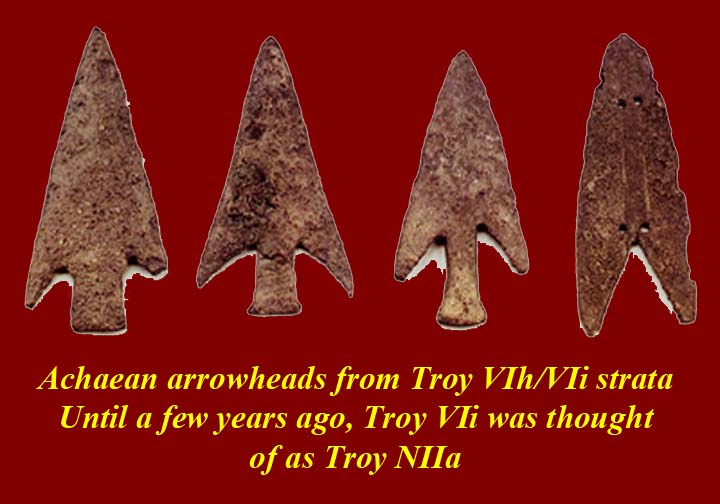
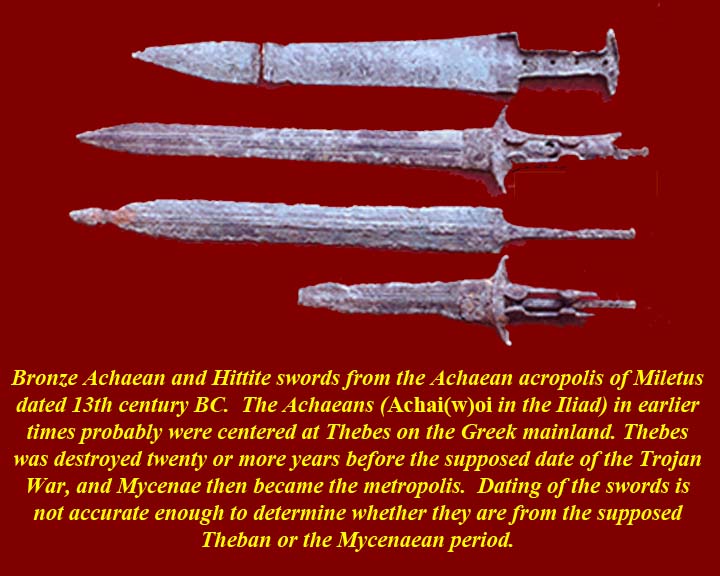
Physical remains of Mycenaean presence abound in western Asia Minor -- Turkey -- both in the form of pottery and artifacts and in the form of instruments of war in destruction levels, including Troy VIh and VIi. After the destructions there is further architectural, artistic, and domestic evidence of Mycenaean influence. Some experts say, however, that some of the evidence may merely be indications of known trade patterns and cultural influence and borrowing.
To some extent, all of this could tie in with the beginning of the Eastern Mediterranean "Dark Age".
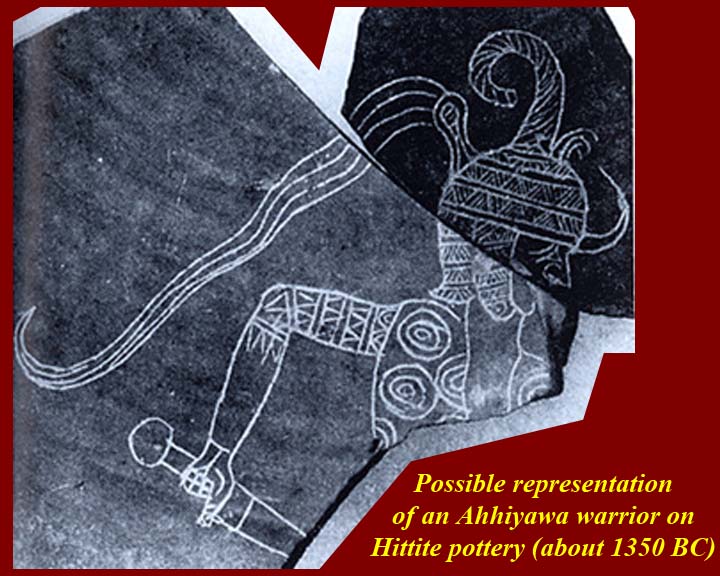
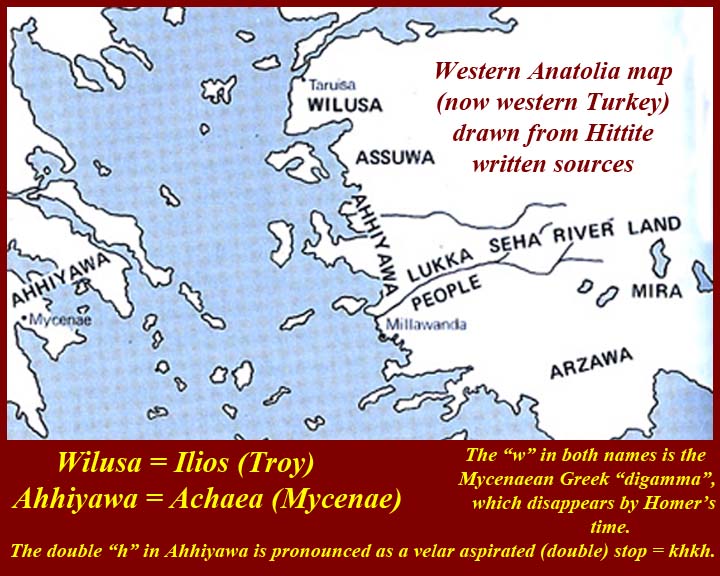
The Hittites, who dominated central Asia Minor (Turkey/Anatolia) an were sometimes hegemons of western coastal Asia Minor including Troy, also left evidence that Mycenaeans were present.
See http://www.academia.edu/219026/Mycenaeans_in_Western_Anatolia for more on Mycenaeans in Anatolia.
Some Trojan War stories
Helen and Paris
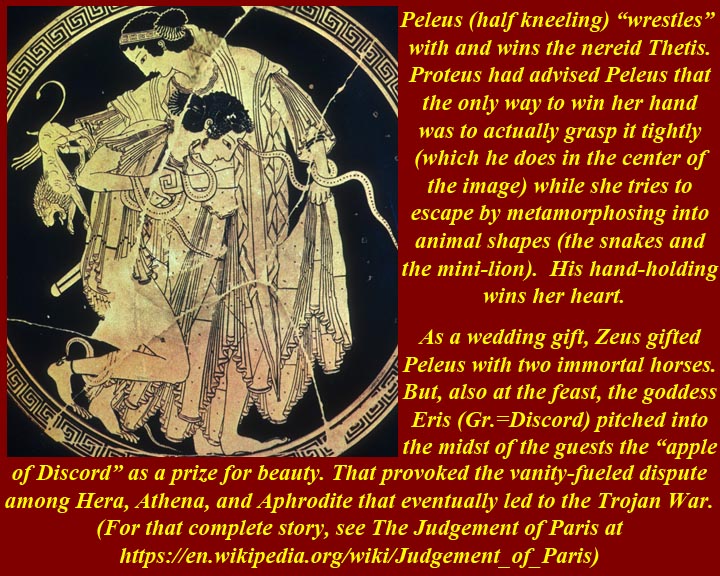
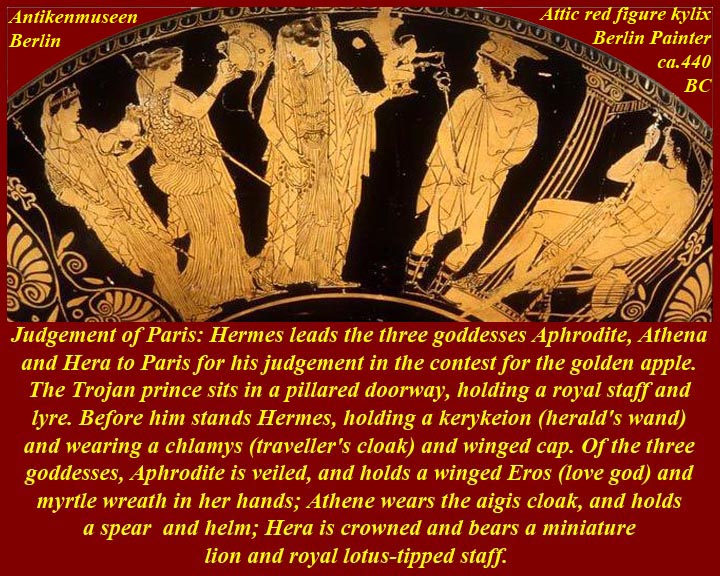
Knowledge of the cause of the Trojan war is widespread in literate western societies. It all began with "the face that launched a thousand ships".
The Face That Launch'd A Thousand Ships
Was this the face that launch'd a thousand ships,
And burnt the topless towers of Ilium?
Sweet Helen, make me immortal with a kiss.
Her lips suck forth my soul: see where it flies!
Come, Helen, come, give me my soul again.
Here will I dwell, for heaven is in these lips,
And all is dross that is not Helena.
I will be Paris, and for love of thee,
Instead of Troy, shall Wittenberg be sack'd;
And I will combat with weak Menelaus,
And wear thy colours on my plumed crest;
Yea, I will wound Achilles in the heel,
And then return to Helen for a kiss.
O, thou art fairer than the evening air
Clad in the beauty of a thousand stars;
Brighter art thou than flaming Jupiter
When he appear'd to hapless Semele;
More lovely than the monarch of the sky
In wanton Arethusa's azur'd arms;
And none but thou shalt be my paramour!
Christopher Marlow
Faust in Doctor Faustus
Scene XIII
There's always a back story:
Peleus courts the Nereid Thetis (a minor sea goddess) by holding on to her hand as she metamorphoses through animal forms until she exhausts her repertoire. At their wedding Eris (= Discord) tosses in the golden apple of discord which will go to the winner of the goddess beauty contest in which Athena, Hera, and Aphrodite compete. The contest judge, Trojan
Paris accepts the bribe of of Aphrodite and judges her the winner. The bribe is, of course, Helen, an already married woman, with whom he absconds. There is some question in the myths about whether she accompanies him willingly.
In Greek mythology, Helen of Troy (Greek Ἑλένη Helénē, pronounced [helénɛː]), AKA Helen of Sparta, was the daughter of Zeus and Leda, and was a sister of Castor, Pollux, and Clytemnestra. In Greek myths, she was considered the most beautiful woman in the world. By marriage she was Queen of Laconia, a province within Homeric Greece, the wife of King Menelaus. Her abduction by Paris, Prince of Troy, brought about the Trojan War. Elements of her putative biography come from classical authors such as Aristophanes, Cicero, Euripides and Homer (both The Iliad and The Odyssey).
A possible back story to the back story
Some modern scholars see the abduction of Helen as an allegoric reference to the fact that Troy was siphoning off Mycenaean profits by imposing tolls and taxes and storage fees on Mycenaean shipping through the Dardanelles (/dɑrdəˈnɛlz/; Turkish: Çanakkale Boğazı, Greek: Δαρδανέλλια, Dardanellia), formerly known as Hellespont (/ˈhɛlɨspɒnt/; Greek: Ἑλλήσποντος, Hellespontos, literally "Sea of Helle"), the narrow strait in northwestern Turkey connecting the Aegean Sea to the Sea of Marmara.
Achilles
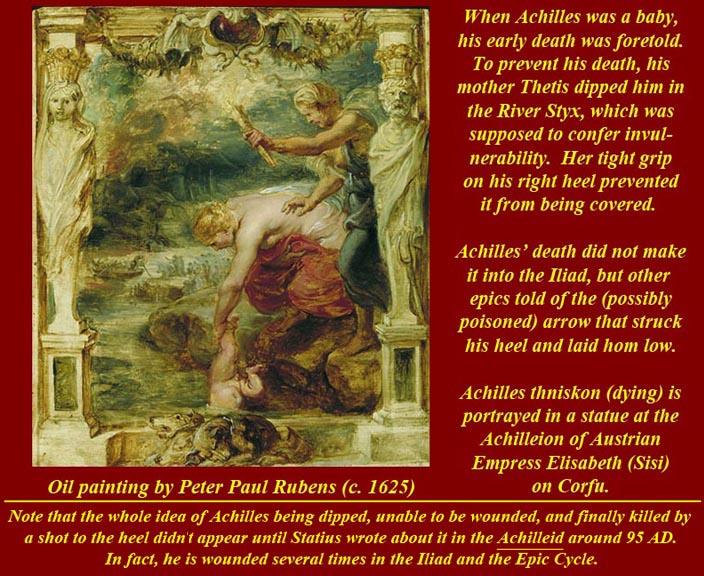
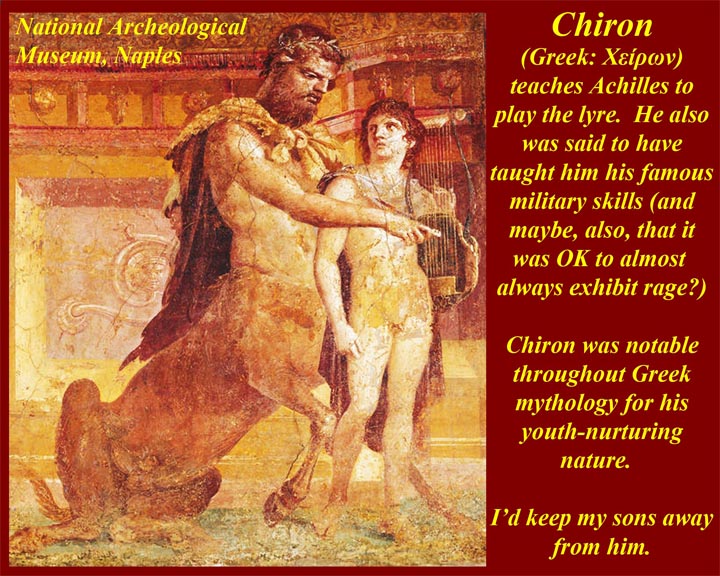
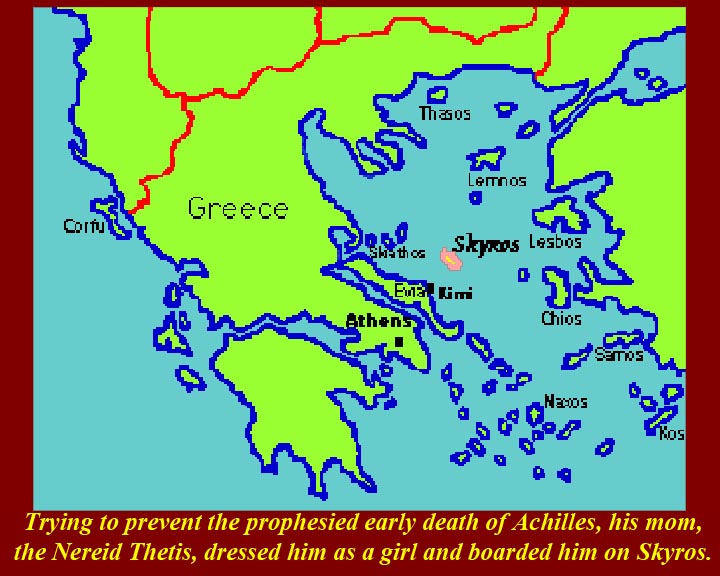
The Iliad is all about the anger of Achilles. One has to wonder about how he got to be so volatile. Well he did have a complicated childhood, adolescence, and young manhood.
After Peleus married Thetis, she had seven children; only Achilles survived. Thetis had been warned that Achilles would be killed in war, so, according to the Roman myths she dipped him in the River Styx holding on to his heel (and thus leaving him with one vulnerable spot, his heel, according to Statius.)
As an adolescent, he was trained (some would say groomed in the pederastial sense of the word) by the famous man child trainer centaur Chiron. (Some psychologists maintain that centaurs represented extreme predatory pederasts, and, indeed, in some cases such men in Rome were sometimes compared to centaurs. (It's hard to tell whether the centaur characterizations preceded the Chiron stories of the other way around.)
And if having his siblings die off piecemeal and being subjected to Chiron's tutelage wasn't enough, his mother, Thetis, dressed him as a girl and sent him off to live among girls, the daughters of King Lykomedes of Skyros. He impregnated the eldest daughter, and then the cross dressing ruse was exposed by a trick of Diomedes and Odysseus, who hauled him off to the war. He probably arrived in Troy already angry.
Agamemnon/Iphigenia/Clytemnestra
Agamemnon of Mycenae, the "Great King" of the Achaeans, chosen to lead the expedition to retrieve Helen. When the winds prevented the combined fleet from sailing he took the word of a priest, who said he should sacrifice his daughter Iphigenia to placate Artemis, the goddess of the wild and of the hunt (known as Diana in other parts of the Mediterranean). Agamemnon according to the myth had slain a favorite deer of Artemis. In some versions of the legend, Agamemnon does kill her, but in other versions Artemis takes into account his willingness to do it and at the last instant whisks Iphigenia away to Tauris and replaces her on the altar with a deer. All of this is especially galling to Achilles because Agamemnon had used a supposed wedding if Iphigenia and Achilles to get Iphigenia to come to Aulis where the assembled army had been preparing to embark.
Later, the supposed sacrifice of Iphigenia was used as a rationalization for the murder of Agamemnon (after he returned from the Trojan War) by Clytemnestra, his wife and the mother of Iphigenia. Actually she appeared (in the myth) to have been in the midst of an affair with Aegisthus, who becomes King replacing Agamemnon and marries Clytemnestra. (If that part of the story sounds familiar, it's because Shakespeare used it for Hamlet.)
https://en.wikipedia.org/wiki/Iphigenia_in_Tauris
https://en.wikipedia.org/wiki/Iphigenia_in_Aulis
https://en.wikipedia.org/wiki/Clytemnestra
https://en.wikipedia.org/wiki/Oresteia
Odysseus and Diomedes
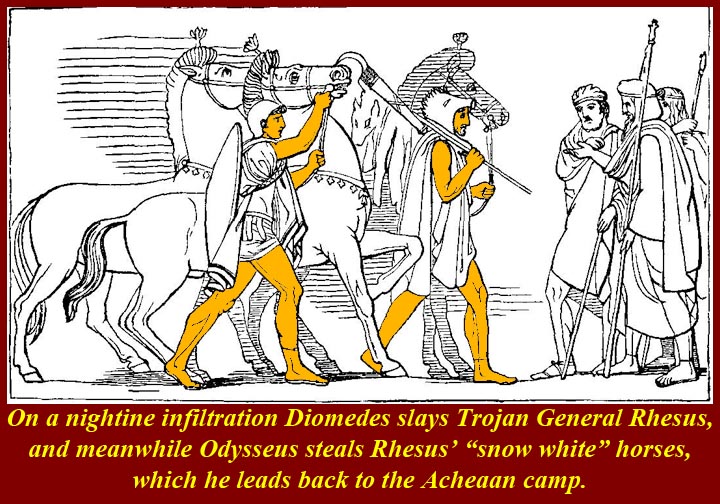
Odysseus (Ulysses in Roman myths) and Diomedes undertake undercover, after dark missions against the Trojans and fulfill two of conditions that were prophesied to be necessary for Achaean victory. They steal the horses of Trojan ally General Rhesus of Thrace, and they steal the Palladion (an idol of Pallas Athene) from the temple of Athena in Troy.
https://en.wikipedia.org/wiki/Rhesus_of_Thrace
https://en.wikipedia.org/wiki/Rhesus_(play)
https://en.wikipedia.org/wiki/Palladium_(classical_antiquity)
https://en.wikipedia.org/wiki/Diomedes
In both the adventures, Diomedes comes off as clever and Odysseus as sneaky.
Odysseus is, of course, the protagonist of the Odyssey and the mythical progenitor, through his son Ascanius Julis, of the Roman Julian gens, which included Romulus and Remus.
Achilles again --- crime and punishment
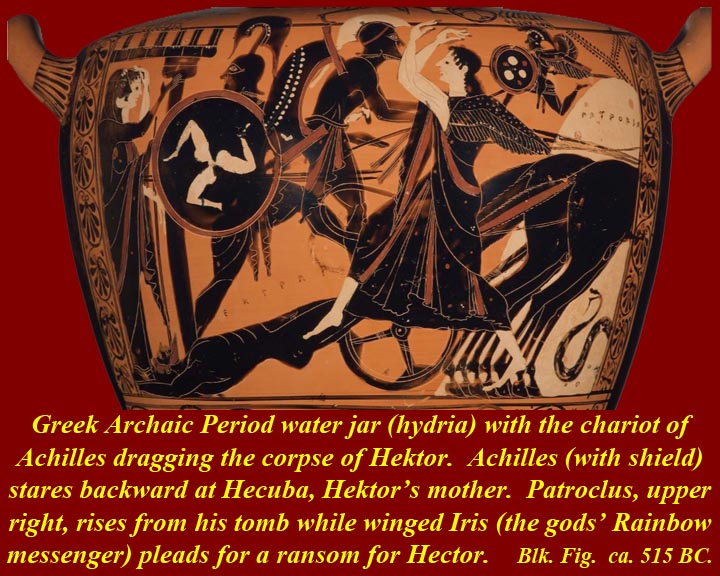
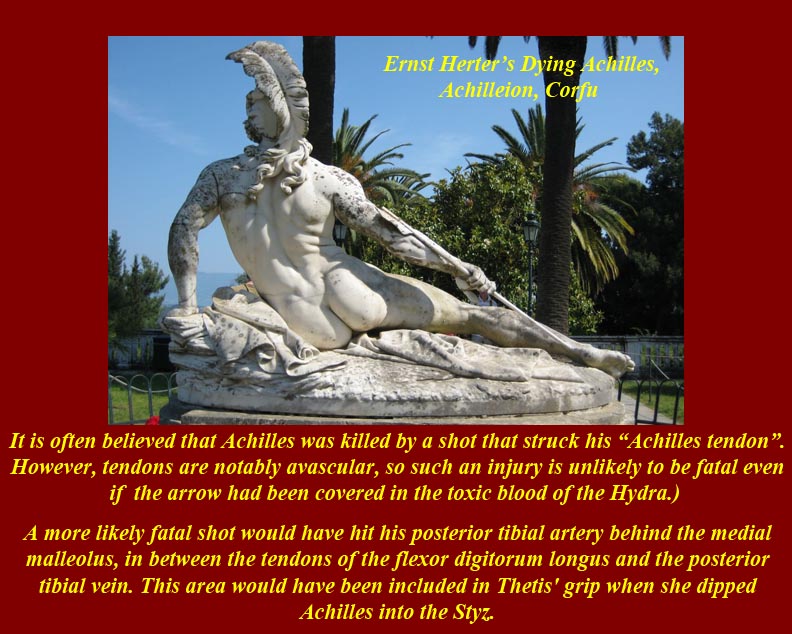

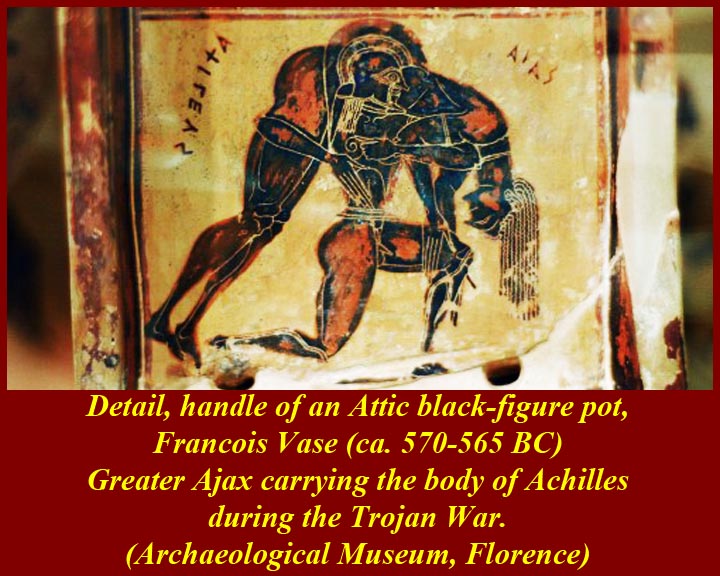
Achilles not only ignores conventions (he had once called a military council without informing his commander, Agamemnon), but now he commits sacrilege by desecrating the body of Hector by dragging it behind his chariot. And he does it in front of Priam and Hecuba, Hector's parents., and in so doing demonstrates impiety. He is finally persuaded by
Iris, the rainbow messenger goddess to listen to Hecuba's request for the return of Hector's body; a twelve day truce is arranged for the funeral ceremonies.
Achilles, being impious once again, violates the funeral truce by ambushing another son and the youngest daughter of Priam and Hecuba. Achilles kills the son, Troilus, and apparently lusts after Polyxena (not mentioned by Homer, but a protagonist in other versions of the story). Priam notices Achilles eying Polyxena and, seeking a way to end the war, proposes a marriage between his daughter and Achilles. Polyxena learns of Achilles week spot on his heel, and she conspires with her brother Paris. She convinces Achilles to kneel in prayer at the temple of Apollo, exposing Achilles heel to an arrow shot by Paris and guided by Apollo, who, like all the gods, was by this time fed up with Achilles.
Achilles dies, and Ajax (the Greater), an old gambling buddy of Achilles, fights off the Trojans who want to desecrate the body of Achilles. Ajax then carries the body back to the Achaean camp.
(The whole story about Thetis dipping Achilles in the River Styx while holding his heel and therefore his heel vulnerability does not get into the myths until Roman times when Statius ((c. A.D. 45-96) writes about it. In Greek versions, Achilles is simply shot dead by Paris.)
Greater Ajax
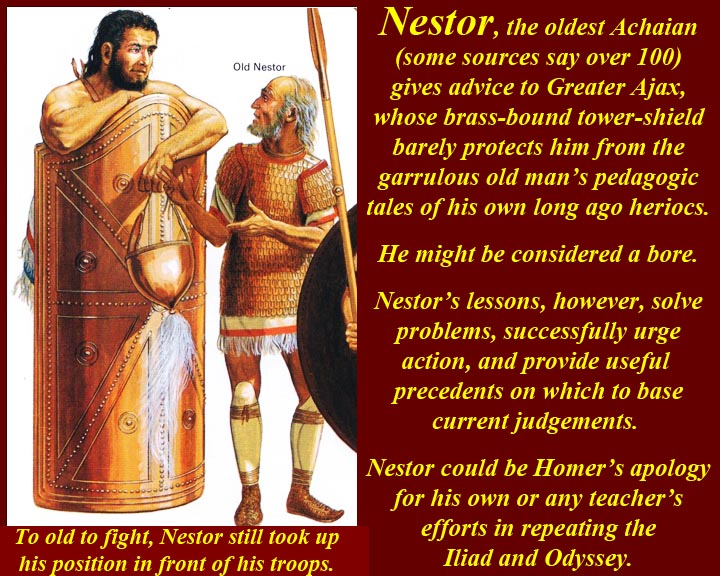
There were two warriors called Ajax in the Achaean forces. The bigger one plays the roll of the big, loyal, lovable, but possibly not to bright friend of Achilles -- and he is the opposite of Achilles in temperament (For those of you who can remember, he's Hoss Cartwright). He is mentored by Nestor, the oldest (by a whole generation) and most experienced of the Achaean commanders.
Ajax thought he should be awarded the armor of Achilles; he was, as we have seen, a good buddy of the man and had fought for Achilles' body and had carried it back. Ajax competed with Odysseus in a speaking contest, and silver tongued Odysseus won the armor. Furious, Ajax cursed Odysseus, which earned the ire of Athena. Athena temporarily made Ajax so mad with grief and anguish that he began killing sheep, thinking them his comrades. After a while, Athena lifted his madness, and Ajax realized that he had actually been killing sheep. Ajax was left so ashamed that he committed suicide by throwing himself on a sword that Hector had given him on the battlefield after they fought to an exhausted draw.
Odysseus eventually gave the armor to Neoptolemus, the son of Achilles.
Neoptolemus
Neoptolemus: the name means "new son of war" -- Achilles was the "old son of war") is portrayed as fighting like a berserker.
He was also called Pyrrhus (/ˈpɪrəs/; Πύρρος, Purrhos, "red", for his red hair), and was the son of Achilles and the princess Deidamia, and also the mythical progenitor of the ruling dynasty of the Molossians of ancient Epirus. (A later Pyrrhus of Epirus won battles against the Romans from 260-275 BC, but they were "Pyrrhic victories".) During and after the war, he killed Priam, Eurypylus, Polyxena, Polites and Astyanax, among others, captured Helenus, and made Andromache his concubine.
The ghost of Achilles appeared to the survivors of the war, demanding Polyxena, the Trojan princess who had conspired with Paris in his death, be sacrificed before anybody could leave. She is not in Homer's Iliad, appearing in works by later poets, perhaps to add romance to Homer's austere tale. In most versions of her story, her throat is slit by Neoptolemus at the foot of the grave of Achilles. (In some versions Polyxena assured her mom, Hecuba, who had already seen most of her and Priam's kids killed, that dying as a virginal sacrifice at Achilles tomb was better than slavery and rape as the "prize" of Neoptolemus.)
https://en.wikipedia.org/wiki/Neoptolemus
The Trojan Horse
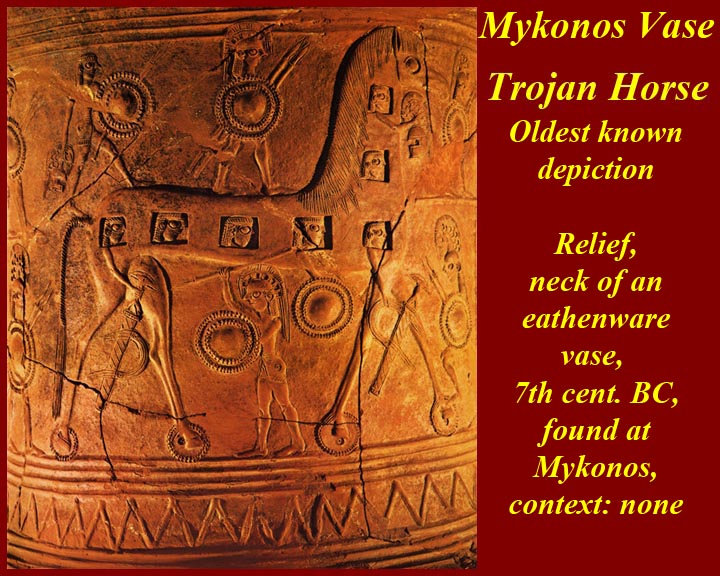
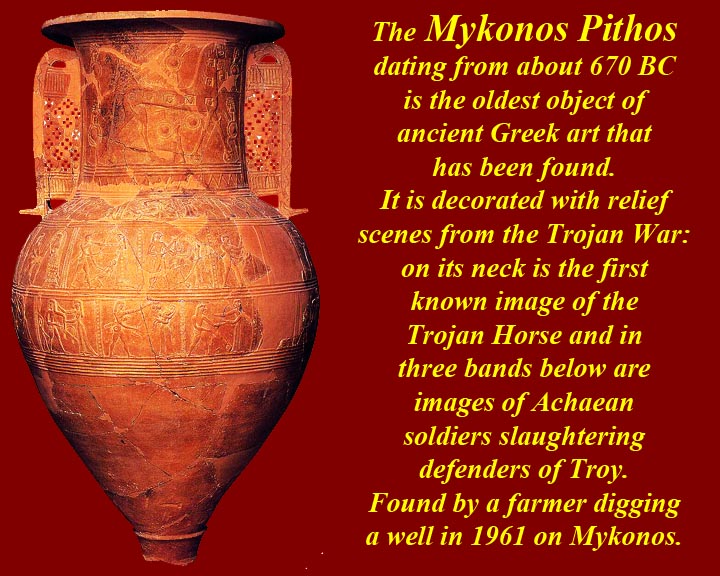
The horse does not appear in the Iliad. The story is referred to in the Odyssey when Demodocus on the island of Scherie of the Phaeacians is urged by Odysseus to tell the story. The most detailed account of the Trojan Horse is in Virgil's Aeneid, a Latin epic poem from the time of Augustus.
The earliest know example of the Trojan Horse in Greek art is the Mykonos Pithos vase, the neck of which is decorated with a relief of the Trojan Horse Lower relief band on the pithos show Greeks slaughtering Trojans after taking their city.
https://en.wikipedia.org/wiki/Trojan_Horse
Aeneas flees Troy
In Greco-Roman mythology, Aeneas (/ɨˈniːəs/; Greek: Αἰνείας, Aineías, possibly derived from Greek αἰνή meaning "praised") was a Trojan hero, the son of the prince Anchises and the goddess Venus (Aphrodite). His father was the second cousin of King Priam of Troy, making Aeneas Priam's second cousin, once removed. He is a character in Greek mythology and is mentioned in Homer's Iliad. Aeneas receives full treatment in Roman mythology, most extensively in Virgil's Aeneid where he is an ancestor of Romulus and Remus. He became the first true hero of Rome.
See https://en.wikipedia.org/wiki/Aeneas.

